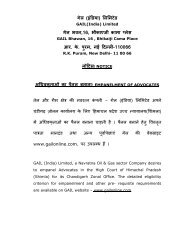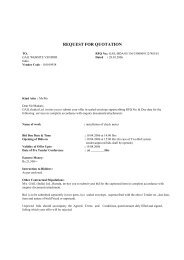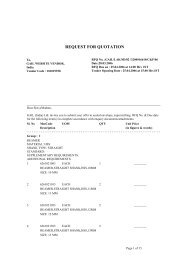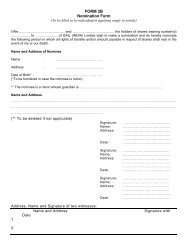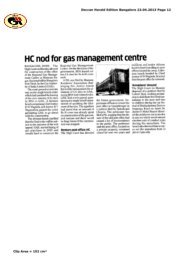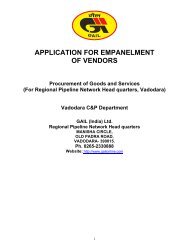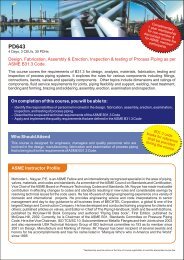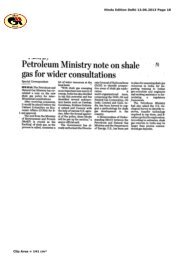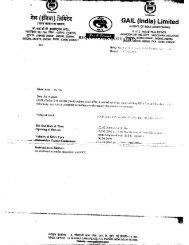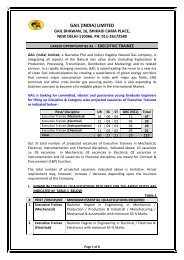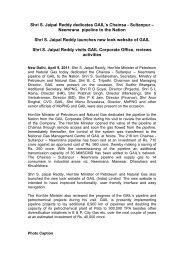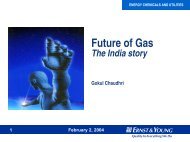Annual Report - 2005-06 - GAIL (India)
Annual Report - 2005-06 - GAIL (India)
Annual Report - 2005-06 - GAIL (India)
You also want an ePaper? Increase the reach of your titles
YUMPU automatically turns print PDFs into web optimized ePapers that Google loves.
A. BALANCE SHEET<br />
1. Fixed Assets<br />
Fixed Assets are valued at historical<br />
cost on consistent basis. In the case<br />
of commissioned assets where<br />
final payment to the Contractors<br />
is pending, capitalization is made<br />
on provisional basis, including<br />
provisional liability pending<br />
approval of Competent Authority,<br />
subject to necessary adjustment in<br />
cost and depreciation in the year of<br />
settlement.<br />
2. Intangible Assets<br />
Intangible assets like software,<br />
licenses and right-of-use of land<br />
including sharing of ROU with<br />
other entities which are expected<br />
to provide future enduring<br />
economic benefits are capitalized<br />
as Intangible Assets.<br />
3. Capital Work in Progress<br />
a. Crop compensation is<br />
accounted for under Capital<br />
Work-in-Progress on the basis<br />
of actual payments/estimated<br />
liability, as and when work<br />
commences where ROU is<br />
acquired.<br />
b. The Capital Work-in-Progress<br />
includes value of materials/<br />
equipments, etc. received at<br />
site for use in the Projects.<br />
4. Borrowing Cost<br />
Borrowing cost of the funds<br />
specifically borrowed for the<br />
purpose of obtaining qualifying<br />
assets and eligible for capitalization<br />
along with the cost of the assets, is capitalized<br />
upto the date when the asset is ready for<br />
use after netting off any income earned on<br />
temporary investment of such funds.<br />
5. Expenses Incurred During Construction<br />
Period<br />
All revenue expenditure incurred during<br />
the year, which is exclusively attributable to<br />
acquisition / construction of fixed assets, is<br />
capitalized at the time of commissioning of<br />
such assets.<br />
6. Depreciation/Amortisation<br />
I. Depreciation on Fixed Assets other than<br />
those mentioned below is provided in<br />
accordance with the rates as specified in<br />
Schedule XIV of the Companies Act, 1956,<br />
on straight line method on pro-rata basis<br />
(monthly pro-rata for bought out assets).<br />
a. Assets costing upto Rs.5,000/- are<br />
depreciated fully in the year of<br />
capitalisation.<br />
b. Bunk Houses are amortised on assumption<br />
of five years life.<br />
c. Oil and Gas Pipelines including other<br />
related facilities are depreciated @ 3.17%<br />
per annum based on useful life of 30 years<br />
d. Computers at the residence of the<br />
employees are depreciated @ 23.75% per<br />
annum. Furniture, Electric Equipments and<br />
Mobiles provided for the use of employees<br />
are depreciated @ 15% per annum.<br />
e. Cost of the leasehold land not exceeding 99<br />
years is amortised over the lease period.<br />
f. Depreciation due to price adjustment on<br />
account of foreign exchange rate variations<br />
or otherwise in the original cost of fixed<br />
assets is charged prospectively.<br />
g. Capital expenditure on the assets (enabling<br />
facilities), the ownership of which is not<br />
with the Company, is charged off to<br />
Revenue.<br />
ACCOUNTING<br />
POLICIES<br />
h. Software / Licences are amortised in<br />
5 years on straight line method.<br />
i. No depreciation is being charged<br />
on ROU being perpetual in nature<br />
j. After impairment of assets, if any,<br />
depreciation is provided on the<br />
revised carrying amount of the<br />
assets over its remaining useful life.<br />
II. Capital assets installed at the<br />
consumers premises on the land<br />
whose ownership is not with the<br />
Company, has been depreciated on<br />
SLM basis in accordance with the<br />
rates as specified in Schedule XIV of<br />
the Company’s Act, 1956.<br />
7. Foreign Currency Translation<br />
a. Loans/other liabilities involving<br />
foreign currency are translated at<br />
the rate of exchange ( BC Selling)<br />
prevailing at the year end . All<br />
exchange difference in respect of<br />
foreign currency transaction are<br />
dealt with in the Profit and Loss<br />
Account except those relating to<br />
acquisition of fixed assets, which<br />
are adjusted in the cost of the<br />
assets.<br />
b. Deposits in Foreign Currency are<br />
valued at the rate of exchange ( TT<br />
Buying) prevailing at the year end.<br />
8. Investments<br />
a. Quoted investments are valued at<br />
cost or market value, whichever is<br />
lower.<br />
b. Unquoted investments are valued<br />
at cost.<br />
c. Long term investments are<br />
valued at cost. Provision is made<br />
to recognise a decline, other<br />
than temporary, in the value of<br />
investments.<br />
9. Inventories<br />
a. Raw materials are valued at cost or<br />
net realisable value, whichever is<br />
lower.<br />
b. Finished products are valued at cost<br />
or net realisable value, whichever is<br />
lower<br />
c. Stock in process is valued at cost or<br />
net realisable value, whichever is<br />
lower. It is valued at cost where the<br />
finished products in which these are<br />
to be incorporated are expected to<br />
be sold at or above cost.<br />
d. Stores and spares and other<br />
material for use in production of<br />
inventories are valued at weighted<br />
average cost or net realisable value,<br />
whichever is lower. It is valued at<br />
weighted average cost where the<br />
finished products in which they will<br />
be incorporated are expected to be<br />
sold at/or above cost.<br />
e. Surplus / Obsolete Stores and<br />
Spares are valued at cost or net<br />
realisable value, which ever is lower<br />
f. Surplus / Obsolete Capital Stores,<br />
other than held for use in<br />
construction of a capital assets,<br />
are valued at lower of cost or net<br />
realisable value.<br />
10. Machinery spares, which can be used<br />
only in connection with an item of fixed<br />
asset and their use is expected to be<br />
irregular, are capitalised with the cost<br />
of that fixed asset and are depreciated<br />
during the remaining useful life of that<br />
asset.<br />
11. Grants<br />
In case of depreciable assets, the cost<br />
of the assets is shown at gross value<br />
and grant thereon is taken to Capital<br />
Reserve which is recognised as income<br />
in the Profit and Loss Account over the<br />
useful life period of the asset.<br />
B. PROFIT & LOSS ACCOUNT<br />
12. Sale proceeds are accounted for based on the<br />
consumer price inclusive of Statutory Levies<br />
and charges upto the place where ownership<br />
of goods is transferred.<br />
13. The interest allocable to operations in respect<br />
of assets commissioned during the year is<br />
worked out by adopting the average of debt<br />
equity ratios at the beginning and closing of<br />
that year and applying the average ratio of<br />
debt thus worked out to the capitalised cost.<br />
14. Pre-project expenditure relating to Projects<br />
which are considered unviable / closed, is<br />
charged off to Revenue over a period of five<br />
years.<br />
15. Retirement Benefits<br />
a. Liability towards Gratuity is paid to a fund<br />
maintained by the Company which is<br />
administered through a separate trust set<br />
up by the Company. Difference between the<br />
fund balance with the trust and the accrued<br />
liability as at the end of the year as per<br />
actuarial valuation is charged to Profit and<br />
Loss Account.<br />
b. Liability towards leave encashment and<br />
post retirement medical benefits to<br />
employees as at the end of the year is<br />
assessed on the basis of actuarial valuation<br />
and provided for.<br />
c. Contribution to Provident Fund as per the<br />
rules of the Company is accounted for on<br />
accrual basis.<br />
16. Taxes on Income<br />
Current tax represents the amount of tax<br />
payable in respect of taxable income for the<br />
period. Deferred tax liability represents the tax<br />
in respect of difference between taxable and<br />
accounting income which originate in one<br />
period and are capable of reversible in one or<br />
more subsequent periods.<br />
17. R&D Expenditure<br />
All expenditure, other than on<br />
capital account, on research and<br />
development are charged to Profit<br />
and Loss Account.<br />
18. Yearly reconciliation of Natural<br />
Gas is made within a limit of ±1%.<br />
In case of variation beyond ±1%<br />
value of excess quantity is kept<br />
in a separate Account “Tolerance<br />
Fluctuation Adjustment Account”<br />
for adjustments in future.<br />
19. Exploration and Development<br />
Costs :-<br />
Successful Efforts Method is being<br />
followed for accounting of Oil &<br />
Gas exploration and production<br />
activities which includes -<br />
a. Survey Costs are expensed in<br />
the year in which these are<br />
incurred.<br />
b. Cost of exploratory wells<br />
is carried as “Exploratory<br />
wells in progresses”. Such<br />
exploratory wells in progress<br />
are capitalized in the year in<br />
which the producing property<br />
is created or is expensed in the<br />
year when determined to be<br />
dry / abandoned.<br />
c. All wells appearing as<br />
“exploratory wells in progress”<br />
which are more than two<br />
years old from the date of<br />
completion of drilling are<br />
charged to Profit and Loss<br />
Account except those wells<br />
which have proved reserves<br />
and the development of the<br />
fields in which the wells are<br />
located has been planned.<br />
Such wells, if any are written<br />
back on commencement of<br />
commercial production.<br />
110 Winning Momentum 111




